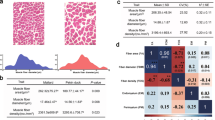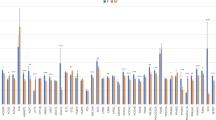Abstract
Most traits and disorders have a multifactorial background indicating that they are controlled by environmental factors as well as an unknown number of quantitative trait loci (QTLs)1,2. The identification of mutations underlying QTLs is a challenge because each locus explains only a fraction of the phenotypic variation3,4. A paternally expressed QTL affecting muscle growth, fat deposition and size of the heart in pigs maps to the IGF2 (insulin-like growth factor 2) region5,6. Here we show that this QTL is caused by a nucleotide substitution in intron 3 of IGF2. The mutation occurs in an evolutionarily conserved CpG island that is hypomethylated in skeletal muscle. The mutation abrogates in vitro interaction with a nuclear factor, probably a repressor, and pigs inheriting the mutation from their sire have a threefold increase in IGF2 messenger RNA expression in postnatal muscle. Our study establishes a causal relationship between a single-base-pair substitution in a non-coding region and a QTL effect. The result supports the long-held view that regulatory mutations are important for controlling phenotypic variation7.
This is a preview of subscription content, access via your institution
Access options
Subscribe to this journal
Receive 51 print issues and online access
$199.00 per year
only $3.90 per issue
Buy this article
- Purchase on Springer Link
- Instant access to full article PDF
Prices may be subject to local taxes which are calculated during checkout



Similar content being viewed by others
References
Mackay, T. F. C. Quantitative trait loci in Drosophila. Nature Rev. Genet. 2, 11–21 (2001)
Andersson, L. Genetic dissection of phenotypic diversity in farm animals. Nature Rev. Genet. 2, 130–138 (2001)
Glazier, A. M., Nadeau, J. H. & Aitman, T. J. Finding genes that underlie complex traits. Science 298, 2345–2349 (2002)
Darvasi, A. & Pisante-Shalom, A. Complexities in the genetic dissection of quantitative trait loci. Trends Genet. 18, 489–491 (2002)
Jeon, J.-T. et al. A paternally expressed QTL affecting skeletal and cardiac muscle mass in pigs maps to the IGF2 locus. Nature Genet. 21, 157–158 (1999)
Nezer, C. et al. An imprinted QTL with major effect on muscle mass and fat deposition maps to the IGF2 locus in pigs. Nature Genet. 21, 155–156 (1999)
King, M. C. & Wilson, A. C. Evolution at two levels in humans and chimpanzees. Science 188, 107–116 (1975)
Nezer, C. et al. Haplotype sharing refines the location of an imprinted QTL with major effect on muscle mass to a 250 Kb chromosome segment containing the porcine IGF2 gene. Genetics 165, 277–285 (2003)
Florini, J. R., Ewton, D. Z. & McWade, F. J. IGFs, muscle growth, and myogenesis. Diabetes Rev. 3, 73–92 (1995)
Evans, G. J. et al. Identification of quantitative trait loci for production traits in commercial pig populations. Genetics 164, 621–627 (2003)
de Koning, D. J. et al. Genome-wide scan for body composition in pigs reveals important role of imprinting. Proc. Natl Acad. Sci. USA 97, 7947–7950 (2000)
Amarger, V. et al. Comparative sequence analysis of the Insulin-IGF2–H19 gene cluster in pigs. Mamm. Genome 13, 388–398 (2002)
Greally, J. M., Guinness, M. E., McGrath, J. & Zemel, S. Matrix-attachment regions in the mouse chromosome 7F imprinted domain. Mamm. Genome 8, 805–810 (1997)
Constancia, M. et al. Deletion of a silencer element in Igf2 results in loss of imprinting independent of H19. Nature Genet. 26, 203–206 (2000)
Eden, S. et al. An upstream repressor element plays a role in Igf2 imprinting. EMBO J. 20, 3518–3525 (2001)
Giuffra, E. et al. The origin of the domestic pig: independent domestication and subsequent introgression. Genetics 154, 1785–1791 (2000)
Grobet, L. et al. A deletion in the bovine myostatin gene causes the double-muscled phenotype in cattle. Nature Genet. 17, 71–74 (1997)
Milan, D. et al. A mutation in PRKAG3 associated with excess glycogen content in pig skeletal muscle. Science 288, 1248–1251 (2000)
Galloway, S. M. et al. Mutations in an oocyte-derived growth factor gene (BMP15) cause increased ovulation rate and infertility in a dosage-sensitive manner. Nature Genet. 25, 279–283 (2000)
Mulsant, P. et al. Mutation in bone morphogenetic protein receptor-IB is associated with increased ovulation rate in Booroola Merino ewes. Proc. Natl Acad. Sci. USA 98, 5104–5109 (2001)
Pailhoux, E. et al. A 11.7-kb deletion triggers intersexuality and polledness in goats. Nature Genet. 29, 453–458 (2001)
Freking, B. A. et al. Identification of the single base change causing the callipyge muscle hypertrophy phenotype, the only known example of polar overdominance in mammals. Genome Res. 12, 1496–1506 (2002)
Grisart, B. et al. Positional candidate cloning of a QTL in dairy cattle: identification of a missense mutation in the bovine DGAT1 gene with major effect on milk yield and composition. Genome Res. 12, 222–231 (2002)
Haley, C. S., Knott, S. A. & Elsen, J. M. Mapping quantitative trait loci in crosses between outbred lines using least squares. Genetics 136, 1195–1207 (1994)
Anderson, S. I., Lopez-Corrales, N. L., Gorick, B. & Archibald, A. L. A large fragment porcine genomic library resource in a BAC vector. Mamm. Genome 11, 811–814 (2000)
Nickerson, D., Tobe, V. O. & Taylor, S. L. PolyPhred: automating the detection and genotyping of single nucleotide substitutions using fluorescent-based resequencing. Nucleic Acids Res. 25, 2745–2751 (1997)
Engemann, S., El-Maarri, O., Hajkova, P., Oswald, J. & Walter, J. in Methods in Molecular Biology Vol. 181 (ed. Ward, A.) (Humana Press, Totowa, New Jersey, 2002)
Andrews, N. C. & Faller, D. V. A rapid micropreparation technique for extraction of DNA-binding proteins from limiting numbers of mammalian cells. Nucleic Acids Res. 19, 2499 (1991)
Kashuk, C., Sengupta, S., Eichler, E. & Chakravarti, A. ViewGene: a graphical tool for polymorphism visualization and characterization. Genome Res. 12, 333–338 (2002)
Acknowledgements
We thank C. Charlier and H. Ronne for discussions, M. Laita, B. McTeir, J. Pettersson, A.-C. Svensson and M. Köping-Höggård for technical assistance, and the Pig Improvement Company for providing DNA samples from Berkshire and Gloucester Old Spot pigs. This work was supported by the Belgian Ministère des Classes Moyennes et de l'Agriculture, the AgriFunGen program at the Swedish University of Agricultural Sciences, the Swedish Research Council for Environment, Agricultural Sciences and Spatial Planning, Gentec, the UK Department for Environment, Food and Rural Affairs, the UK Pig Breeders Consortium, and the Biotechnology and Biological Sciences Research Council.
Author information
Authors and Affiliations
Corresponding authors
Ethics declarations
Competing interests
Patent applications concerning the commercial application of the IGF2 QTL have been filed by Melica HB, Sweden (represented by Leif Andersson), University of Liege, Belgium (represented by Michel Georges) and Gentec, Belgium (represented by Nadine Buys).
Supplementary information
Rights and permissions
About this article
Cite this article
Van Laere, AS., Nguyen, M., Braunschweig, M. et al. A regulatory mutation in IGF2 causes a major QTL effect on muscle growth in the pig. Nature 425, 832–836 (2003). https://doi.org/10.1038/nature02064
Received:
Accepted:
Issue Date:
DOI: https://doi.org/10.1038/nature02064
This article is cited by
-
Genome-wide detection of selection signatures in Jianli pigs reveals novel cis-regulatory haplotype in EDNRB associated with two-end black coat color
BMC Genomics (2024)
-
Detection of DNA methylation signatures through the lens of genomic imprinting
Scientific Reports (2024)
-
The polymorphism of the ovine insulin like growth factor-2 (IGF2) gene and their associations with growth related traits in Tibetan sheep
Tropical Animal Health and Production (2024)
-
Association of the single nucleotide polymorphism in CAPN3 gene with growth performance in Merino and Garut (MEGA) backcross sheep
Journal of Genetic Engineering and Biotechnology (2023)
-
Single-base editing in IGF2 improves meat production and intramuscular fat deposition in Liang Guang Small Spotted pigs
Journal of Animal Science and Biotechnology (2023)
Comments
By submitting a comment you agree to abide by our Terms and Community Guidelines. If you find something abusive or that does not comply with our terms or guidelines please flag it as inappropriate.



